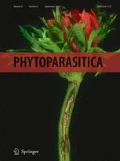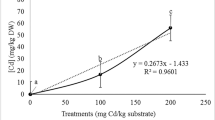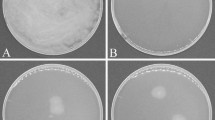Abstract
Cyanobacteria and their interactions with phytopathogenic fungi in soil-less potting mixes is a less explored aspect in the protected cultivation of crops, as fungal diseases often bring about serious losses. The nursery of tomato was raised with A. laxa amended /unamended soil-less substrate mixes [P:C, perlite: cocopeat (1:1); C:V, cocopeat: vermiculite (1:1); P:C:V, perlite: cocopeat: vermiculite: (1:1:1)]. Preliminary investigation of percent germination of tomato seeds in the different media with the treatments illustrated the differential influence of the media, and Anabaena laxa amended treatments showing highest values, including those challenged with F. solani. To further understand the nature of such interactions in the rhizosphere, transplantation of 30 d-old seedlings was undertaken in mesocosm experiments deploying soil-less substrate mixes (P:C, C:V, P:C:V) challenged with /without Fusarium solani or Rhizoctonia solani. Significant increases of 10–46% were recorded in the total soil polysaccharides and dehydrogenase activity with F. solani, and in IAA with R. solani, compared to control. Among the treatments, T4 (A. laxa ± Fs) showed an almost 60% increase in terms of nitrogen and organic carbon content. This illustrated that A. laxa effectively interacted with both fungi and improved the nutrient availability in the media; interestingly, F. solani exhibited a growth stimulatory role. Cyanobacterium-fungal interactions led to better growth of tomato plants, illustrating that A. laxa amendment can be a promising option, particularly, in P:C:V, as media for developing robust and disease-free nurseries.





Similar content being viewed by others
Data availability
All the data is provided, included as Supplementary Information.
Code availability
Not applicable.
References
Bharti, A., Prasanna, R., Kumar, G., Kumar, A., & Nain, L. (2019). Co-cultivation of cyanobacteria for raising nursery of Chrysanthemum using a hydroponic system. Journal of Applied Phycology, 31(6), 3625–3635. https://doi.org/10.1007/s10811-019-01830-9
Bharti, A., Prasanna, R., Velmourougane, K., Kumar, A., Shivay, Y. S., & Nain, L. (2020). Development of nutrient-rich media through cyanobacterial amendment and their characterization. Waste and Biomass Valorization, 11(11), 6003–6016. https://doi.org/10.1007/s12649-019-00829-0
Bharti, A., Prasanna, R., Kumar, G., Nain, L., Rana, A., Ramakrishnan, B., & Shivay, Y. S. (2021). Cyanobacterium-primed Chrysanthemum nursery improves performance of the plant and soil quality. Biology and Fertility of Soils, 57(1), 87–105. https://doi.org/10.1007/s00374-020-01494-5
Bidyarani, N., Prasanna, R., Babu, S., Hossain, F., & Saxena, A. K. (2016). Enhancement of plant growth and yields in Chickpea (Cicer arietinum L.) through novel cyanobacterial and biofilmed inoculants. Microbiological Research, 188, 97–105. https://doi.org/10.1016/j.micres.2016.04.005
Bitas, V., McCartney, N., Li, N., Demers, J., Kim, J.-E., Kim, H.-S., et al. (2015). Fusarium oxysporum volatiles enhance plant growth via affecting auxin transport and signaling. Frontiers in Microbiology, 6, 1248. https://doi.org/10.3389/fmicb.2015.01248.
Casida, L. E., Jr., Klein, D. A., & Santoro, T. (1964). Soil dehydrogenase activity. Soil Science, 98(6), 371–376.
Chang, K. F., Hwang, S. F., Ahmed, H. U., et al. (2017). Disease reaction to Rhizoctonia solani and yield losses in soybean. Canadian Journal of Plant Sciences, 98(1), 115–124. https://doi.org/10.1139/cjps-2017-0053
Chauhan, S., Wadhwa, K., Vasudeva, M., & Narula, N. (2012). Potential of Azotobacter spp. as biocontrol agents against Rhizoctonia solani and Fusarium oxysporum in cotton (Gossypium hirsutum), guar (Cyamopsis tetragonoloba) and tomato (Lycopersicum esculentum). Archives of Agronomy and Soil Science, 58(12), 1365–1385. https://doi.org/10.1080/03650340.2011.590134
Chaudhary, V., Prasanna, R., Nain, L., Dubey, S. C., Gupta, V., Singh, R., Jaggi, S., Bhatnagar, A. K. (2012). Bioefficacy of novel cyanobacteria-amended formulations in suppressing damping off disease in tomato seedlings. World Journal of Microbiology and Biotechnology 28, 3301–3310.
Das, M., Haridas, M., & Sabu, A. (2019). Biological control of black pepper and ginger pathogens, Fusarium oxysporum, Rhizoctonia solani and Phytophthora capsici, using Trichoderma spp. Biocatalysis and Agricultural Biotechnology, 1(17), 177–183. https://doi.org/10.1016/j.bcab.2018.11.021
Dixit, R., Agrawal, L., Gupta, S., Kumar, M., Yadav, S., Chauhan, P. S., & Nautiyal, C. S. (2016). Southern blight disease of tomato control by 1-aminocyclopropane-1-carboxylate (ACC) deaminase producing Paenibacillus lentimorbus B-30488. Plant Signaling & Behaviour, 11(2), e1113363. https://doi.org/10.1080/15592324.2015.1113363
Dukare, A. S., Prasanna, R., Dubey, S. C., Chaudhary, V., Nain, L., Singh, R., & Saxena, A. K. (2011). Evaluating novel microbe amended composts as biocontrol agents in tomato. Crop Protection, 30, 436–442.
Egamberdieva, D., Wirth, S. J., Alqarawi, A. A., Abd Allah, E. F., & Hashem, A. (2017). Phytohormones and beneficial microbes: Essential components for plants to balance stress and fitness. Frontiers in Microbiology, 8, 2104. https://doi.org/10.3389/fmicb.2017.02104
El-Mohamedy, R. S., Jabnoun-Khiareddine, H., & Daami-Remadi, M. (2014). Control of root rot diseases of tomato plants caused by Fusarium solani, Rhizoctonia solani and Sclerotium rolfsii using different chemical plant resistance inducers. Tunisian Journal of Plant Protection, 9(1), 45–55.
Fan, P., Lai, C., Yang, J., et al. (2020). Crop rotation suppresses soil-borne Fusarium wilt of banana and alters microbial communities. Archives of Agronomy and Soil Science, 68, 447–459. https://doi.org/10.1080/03650340.2020.1839058
Ghosh, T. K., & Saha, K. C. (1997). Effects of inoculation of cyanobacteria on nitrogen status and nutrition of rice (Oryza sativa L.) in an Entisol amended with chemical and organic sources of nitrogen. Biology and Fertility of Soils, 24(1), 123–128. https://doi.org/10.1007/BF01420232
Gulia, U., Shukla, J., Nishanth, S., Kokila, V., Bharti, A., Singh, A. K., Shivay, Y. S., & Prasanna, R. (2022). Fortifying nursery soil-less media with cyanobacteria for enhancing the growth of tomato. South African Journal of Botany, 146, 564–572.
Gupta, V., Ratha, S. K., Sood, A., Chaudhary, V., & Prasanna, R. (2013). New insights into the biodiversity and applications of cyanobacteria (blue-green algae)-prospects and challenges. Algal Research, 2(2), 79–97. https://doi.org/10.1016/j.algal.2013.01.006
Hofte, M., & Altier, N. (2010). Fluorescent pseudomonads as biocontrol agents for sustainable agricultural systems. Research in Microbiology, 161(6), 464–471. https://doi.org/10.1016/j.resmic.2010.04.007
Issa, O. M., Le Bissonnais, Y., Défarge, C., & Trichet, J. (2001). Role of a cyanobacterial cover on structural stability of sandy soils in the Sahelian part of western Niger. Geoderma, 101(3–4), 15–30. https://doi.org/10.1016/S0016-7061(00)00093-8
Jaiswal, P., Singh, P. K., & Prasanna, R. (2008). Cyanobacterial bioactive molecules—an overview of their toxic properties. Canadian Journal of Microbiology, 54(9), 701–717. https://doi.org/10.1139/W08-034
Jetiyanon, K., & Kloepper, J. W. (2002). Mixtures of plant growth-promoting rhizobacteria for induction of systemic resistance against multiple plant diseases. Biological Control, 24(3), 285–291. https://doi.org/10.1016/S1049-9644(02)00022-1
Kanchan, A., Simranjit, K., Ranjan, K., Prasanna, R., Ramakrishnan, B., Singh, M. C., Hasan, M., & Shivay, Y. S. (2019). Microbial biofilm inoculants benefit growth and yield of Chrysanthemum varieties under protected cultivation through enhanced nutrient availability. Plant Biosystems, 153(2), 306–316. https://doi.org/10.1080/11263504.2018.1478904
Karima, H. E., & Nadia, G. E. (2012). In vitro study on Fusarium solani and Rhizoctonia solani isolates causing the damping off and root rot diseases in tomatoes. Nature and Science, 10(11), 16–25.
Kessmann, H., Staub, T., Hofmann, C., Maetzke, T., Herzog, J., Ward, E., Uknes, S., & Ryals, J. (1994). Induction of systemic acquired disease resistance in plants by chemicals. Annual Reviews of Phytopathology, 32(1), 439–459.
Klock, K. A. (1997). Growth of salt sensitive bedding plants in media amended with composted urban waste. Compost Science and Utilization, 5(3), 55–59.
Kokila, V., Prasanna, R., Kumar, A., Nishanth, S., Shukla, J., Gulia, U., Nain, L., Shivay, Y. S., & Singh, A. K. (2022). Cyanobacterial inoculation in elevated CO2 environment stimulates soil C enrichment and plant growth of tomato. Environmental Technology and Innovation, 26, 102234. https://doi.org/10.1016/j.eti.2021.102234
Liu, A., Ma, B. L., & Bomke, A. A. (2005). Effects of cover crops on soil aggregate stability, total organic carbon and polysaccharide. Soil Science Society of America Journal, 69, 2041–2048. https://doi.org/10.2136/sssaj2005.0032
Mahawar, H., Prasanna, R., & Gogoi, R. (2019). Elucidating the disease alleviating potential of cyanobacteria, copper nanoparticles and their interactions in Fusarium solani challenged tomato plants. Plant Physiology Reports, 24, 533–540.
Manici, L. M., Kelderer, M., Caputo, F., & Mazzola, M. (2015). Auxin-mediated relationships between apple plants and root inhabiting fungi: Impact on root pathogens and potentialities of growth-promoting populations. Plant Pathology, 64, 843–851. https://doi.org/10.1111/ppa.12315
Minerdi, D., Bossi, S., Maffei, M. E., Gullino, M. L., & Garibaldi, A. (2011). Fusarium oxysporum and its bacterial consortium promote lettuce growth and expansin A5 gene expression through microbial volatile organic compound (MVOC) emission. FEMS Microbiology Ecology, 76, 342–351. https://doi.org/10.1111/j.1574-6941.2011.01051.x
Namikoshi, M., & Rinehart, K. L. (1996). Bioactive compounds produced by cyanobacteria. Journal of Industrial Microbiology, 17(5–6), 373–384. https://doi.org/10.1007/BF01574768
Nayak, S., Prasanna, R., Pabbi, A., Dominic, T. K., & Singh, P. K. (2004). Effect of urea and BGA-Azolla bio-fertilizers on nitrogen fixation and chlorophyll accumulation in soil cores from rice fields. Biology and Fertility of Soils, 40, 67–72.
Nisha, R., Kaushik, A., & Kaushik, C. P. (2007). Effect of indigenous cyanobacterial application on structural stability and productivity of an organically poor semi-arid soil. Geoderma, 138(1–2), 49–56.
Prasad, R., Shivay, Y.S., Kumar, D., Sharma, .SN. (2006). Learning by doing exercises in soil fertility (A practical manual for soil fertility) Division of Agronomy (pp. 68). IARI.
Prasanna, R., Nain, L., Tripathi, R., et al. (2008). Evaluation of fungicidal activity of extracellular filtrates of cyanobacteria–possible role of hydrolytic enzymes. Journal of Basic Microbiology, 48(3), 186–194. https://doi.org/10.1002/jobm.200700199
Prasanna, R., Gupta, V., Natarajan, C., & Chaudhary, V. (2010). Bioprospecting for genes involved in the production of chitosanases and microcystin-like compounds in Anabaena strains. World Journal of Microbiology and Biotechnology, 26(4), 717–724. https://doi.org/10.1007/s11274-009-0228-7
Prasanna, R., Babu, S., Rana, A., et al. (2013). Evaluating the establishment and agronomic proficiency of cyanobacterial consortia as organic options in wheat-rice cropping sequence. Experimental Agriculture, 49(3), 416–434. https://doi.org/10.1017/S001447971200107X
Prasanna, R., Babu, S., Bidyarani, N., et al. (2015). Prospecting cyanobacteria-fortified composts as plant growth promoting and biocontrol agents in cotton. Experimental Agriculture, 51(1), 42–65. https://doi.org/10.1017/S0014479714000143
Prasanna, R., Gupta, H., Yadav, V. K., et al. (2020). Prospecting the promise of cyanobacterial formulations developed using soil-less substrates as carriers. Environmental Technology and Innovation, 18, 100652. https://doi.org/10.1016/j.eti.2020.100652
Raynaldo, F. A., Dhanasekaran, S., Ngea, G. L. N., Yang, Q., Zhang, X., & Zhang, H. (2021). Investigating the biocontrol potentiality of Wickerhamomyces anomalus against postharvest gray mold decay in cherry tomatoes. Scientia Horticulturae, 285, 110137. https://doi.org/10.1016/j.scienta.2021.110137
Renuka, N., Guldhe, A., Prasanna, R., Singh, P., & Bux, F. (2018). Microalgae as multi-functional options in modern agriculture: Current trends, prospects, and challenges. Biotechnology Advances, 36(4), 1255–1273. https://doi.org/10.1016/j.biotechadv.2018.04.004
Santhakumari, S., Kannappan, A., Pandian, S. K., Thajuddin, N., Rajendran, R. B., & Ravi, A. V. (2016). Inhibitory effect of marine cyanobacterial extract on biofilm formation and virulence factor production of bacterial pathogens causing vibriosis in aquaculture. Journal of Applied Phycology, 28(1), 313–324.
Sergeeva, E., Liaimer, A., & Bergman, B. (2002). Evidence for production of the phytohormone indole-3-acetic acid by cyanobacteria. Planta, 215(2), 229–238. https://doi.org/10.1007/s00425-002-0749-x
Syed Ab Rahman, S. F., Singh, E., Pieterse, C. M. J., & Schenk, P. M. (2018). Emerging microbial biocontrol strategies for plant pathogens. Plant Science, 267, 102–111.
Thakur, M. S., & Vyas, K. M. (1983). Production of plant growth regulators by some Fusarium species. Folia Microbiologica (Praha), 28(2), 124–129. https://doi.org/10.1007/BF02877368
Tsavkelova, E., Oeser, B., Oren-Young, L., Israeli, M., Sasson, Y., Tudzynski, B., & Sharon, A. (2012). Identification and functional characterization of indole-3- acetamide-mediated IAA biosynthesis in plant-associated Fusarium species. Fungal Genetics and Biology, 49, 48–57.
Verdonck, O., De Vleeschauwer, D., & De Boodt, M. (1982). The influence of the substrate to plant growth. Acta Horticulturae, 126, 251–258.
Wang, D., Gabriel, M. Z., Legard, D., & Sjulin, T. (2016). Characteristics of growing media mixes and application for open-field production of strawberry (Fragaria ananassa). Scientia Horticuturae, 198, 294–303. https://doi.org/10.1016/j.scienta.2015.11.023
Zhalnina, K., Dias, R., de Quadros, P. D., et al. (2015). Soil pH determines microbial diversity and composition in the park grass experiment. Microbial Ecology, 69(2), 395–406.
Acknowledgements
The authors are grateful to the Indian Council of Agricultural Research (ICAR) for funds facilitated by the Network Project on Microorganisms “Application of Microorganisms in Agricultural and Allied Sectors” (AMAAS) New Delhi. The authors also thank the Division of Microbiology, Division of Agronomy, National Phytotron Facility (NPF) and Centre for Protected Cultivation Technology (CPCT), ICAR-IARI, for providing all the necessary facilities. Shri Gulab Singh is gratefully acknowledged for his help in the nutrient analyses.
Funding
Partly through the Indian Council of Agricultural Research (ICAR) funded Network Project on Microorganisms “Application of Microorganisms in Agricultural and Allied Sectors” (AMAAS) New Delhi.
Author information
Authors and Affiliations
Contributions
RP conceptualized, planned and supervised the experiments; JS and UG conducted the experiments and analysed the data; JS wrote the draft manuscript, with inputs from UG, SN, HG, KG, HM who also helped in the analyses. LN, RG and GS provided useful inputs for the experimental work; AKS and AK helped in the raising of tomato nursery and YSS helped in the nutrient analyses, all provided critical inputs. RP undertook the final editing of the manuscript. All the authors approved the final version submitted.
Corresponding author
Ethics declarations
Ethics approval
Not relevant/applicable to the study.
Consent to participate
All the authors have participated in the investigation and writing of the manuscript.
Consent for publication
All the authors have consented to the publication.
Conflicts of interest/Competing interests
The authors declare that they have no conflict of interest or known competing interests.
Additional information
Publisher's note
Springer Nature remains neutral with regard to jurisdictional claims in published maps and institutional affiliations.
Supplementary Information
Below is the link to the electronic supplementary material.

ESM 1
Supplementary Fig. 1 Evaluation of selected microbiological parameters of cyanobacterium-amended potting media- tomato plant interactions and challenge of Rhizoctonia solani 48 DAT in soil mesocosm experiment. Rs, Rhizoctonia solani; IAA, indole-3- acetic acid; DAT, days after transplantation in pot; P:C, perlite: cocopeat (1:1); C:V, cocopeat: vermiculite (1:1); P:C:V, perlite: cocopeat: vermiculite (1:1:1). Data are means ± SD (n = 3) and P ≤ 0.05 (PNG 432 kb)
ESM 2
Supplementary Fig. 2 Estimation of organic carbon (in terms of percent increase over T1 Control) in cyanobacterium-amended potting media challenged with F. solani (a) among microbial amendments (b) among potting mixes and challenged with R. solani (c) among microbial amendments (b) among potting mixes, at 48 DAT. All experiments were done with tomato plants. Fs, Fusarium solani; Rs, Rhizoctonia solani; DAT, days after transplantation into pot; P: C, perlite: cocopeat (1:1); C: V, cocopeat: vermiculite (1:1); P: C: V, perlite: cocopeat: vermiculite (1:1:1); T1, Control; T2, A. laxa; T3, Fs/Rs; T4, A. laxa + Fs; T5, Biological control+ Fs; T6, Chemical control+ Fs/Rs. Data are means ± SD (n = 3) and P ≤ 0.05 (PDF 61 kb)
Rights and permissions
About this article
Cite this article
Shukla, J., Gulia, U., Gupta, H. et al. Harnessing cyanobacterium-fungal interactions to develop potting mixes for disease-free tomato nursery. Phytoparasitica 51, 703–716 (2023). https://doi.org/10.1007/s12600-022-01011-4
Received:
Accepted:
Published:
Issue Date:
DOI: https://doi.org/10.1007/s12600-022-01011-4




